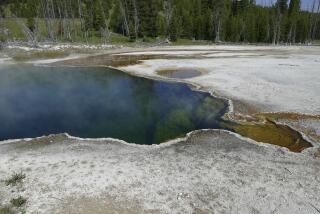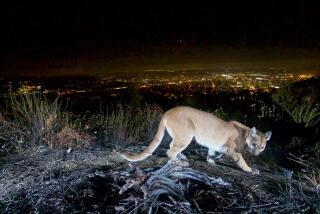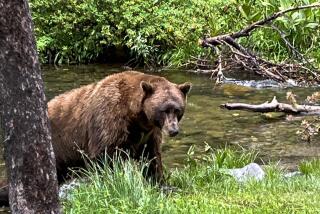Grizzly bear that killed Yellowstone hiker euthanized, officials say
You are more likely to be killed by lightning, or maybe a bee, than by a bear.
But those odds in Yellowstone National Park -- 1 in 2.1 million -- didn’t help a 63-year-old man from Billings, Mont. Lance Crosby’s body was found last week, partially consumed and covered with pine needles and seeds, an unmistakable sign that a bear would be back to feed.
On Thursday, park officials said they had euthanized an adult female grizzly involved in the attack.
As hundreds of angry calls and emails flooded the Yellowstone office, however, officials said their decision to put down the animal was not taken lightly.
“As park managers, we are constantly working to strike a balance between the preservation of park resources and the safety of our park visitors and employees,” Yellowstone National Park Supt. Dan Wenk said in a statement. “Our decision is based on the totality of the circumstances in this unfortunate event.”
Park officials said they had confirmed the grizzly captured at the scene was involved in the attack from a DNA analysis of bear hair collected next to Crosby’s body. Investigators also found bear tracks near him, and canine puncture wounds were consistent with the bear’s bite size.
The bear had been caught in a trap set by wildlife biologists hours after Crosby was reported missing Friday morning.
Crosby was found dead Friday night near the Elephant Back Loop Trail, a popular off-trail area he was known to frequent. A long-term employee of Medcor, a company that operates three urgent-care clinics in the park, he had lived and worked in Yellowstone for five seasons.
Amy Bartlett, a park spokeswoman, said Crosby was alone at the time of the attack and carried no bear spray. Yellowstone visitors are advised to stay on designated trails, to travel in groups of three or more, to make noise on the trail, to use bear spray if a bear attacks, and not to run.
Bartlett said officials did not know why Crosby, an experienced hiker, was not carrying bear spray, or whether the bear’s attack was defensive or predatory.
“Unfortunately, we never will,” she said.
The bear had two cubs, which also were captured.
If a hiker were to get between a bear and her cubs, she would be likely to attack to protect her offspring. In such a defensive attack, however, a bear typically would leave once the threat had been neutralized.
“This bear didn’t leave,” Bartlett said, adding that an autopsy revealed there had been “significant consumption.”
Park officials said the cubs would be placed in a zoo because they would be unlikely to survive in the wild without their mother. Details were expected to be made public Friday.
The Yellowstone grizzly management program, which has been in place since 1983, aims to minimize bear-human interactions, prevent human-caused displacement of bears from prime food sources, and decrease the risk of bear-caused injuries. The aim is to strike a balance between preserving park resources and protecting the park’s approximately 3.5 million annual visitors.
There are roughly 750 grizzlies in the greater Yellowstone ecosystem, which encompasses about 20,000 square miles. Attacks are rare but not unheard of.
In 2011, two day hikers were killed in separate grizzly attacks in the park. Before that, the last fatal attack was in 1986, when a photographer was killed by an adult female grizzly near Otter Creek in the Hayden Valley area of the park.
According to the Yellowstone website, more people in the park have died of drowning, burns and suicide than have been killed by bears.
Also Thursday, another grizzly was euthanized after raiding residential areas near Cody, Wyo., about 20 miles east of Yellowstone. In a statement, Wyoming Game and Fish Department officials said the bear had been caught in the area before and relocated several times, but it kept returning to residential areas.
Twitter: @natalieschachar
More to Read
Sign up for Essential California
The most important California stories and recommendations in your inbox every morning.
You may occasionally receive promotional content from the Los Angeles Times.










